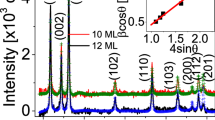Abstract
Experimental data on the dielectric spectra of the organic films were studied and analyzed. An equivalent circuit consisting of two series-parallel RC- circuits is used for computer modeling and interpretation of experimental data of films with negative electrical capacitance in the high-frequency range. The critical frequency of changing the sign of the electrical capacitance has been determined. The negative electrical capacitance of the films under study is due to two factors: high-frequency processes of strong relaxation polarization with inverse electric field strength and low-frequency processes of hop**-type conductivity.
Access this chapter
Tax calculation will be finalised at checkout
Purchases are for personal use only
Similar content being viewed by others
References
Kuznetsov, V.: Organic Ingibitors of Corrosion of Metals. Plenum Press, New York and London (1996)
Plotnikov, G.S., Zaitsev, V.B.: Physical Foundations of Molecular Electronics. Moscow State University, Moscow (2000)
Shulman, J., Xue, Y.Y., Tsui, S., Chen, F., Chu, C.W.: General mechanism for negative capacitance phenomena. Phys. Rev. B 80, 134202 (2009)
Yadav, A.K., Nguyen, K.X., Hong, Z., et al.: Spatially resolved steady-state negative capacitance. Nature 565, 468–471 (2019)
Turik, A.V., Bogatin, A.S.: Non-Debye relaxation and resonance phenomena in dielectric spectra of CaCu3Ti4O12 family functional ceramic materials. Funct. Mater. Lett. (Singapore) 8(4), 155003(1–4) (2015)
Makarov, V.V., Sherman, A.B.: Low-frequency dispersion of the negative dielectric permittivity in C70 films. Phys. Solid State 44(11), 2101–2105 (2002)
Íñiguez, J., Zubko, P., Luk’yanchuk, I., Cano, A.: Antiferroelectric negative capacitance from a structural phase transition in zirconia. Nat. Rev. Mater. 4, 243–256 (2019)
Malvika, C.B., Mummaneni, K.: A review on a negative capacitance field-effect transistor for low-power applications. J. Electron. Mater. 51, 923–937 (2022)
Alam, M.A., Si, M., Ye, P.D.: A critical review of recent progress on negative capacitance field-effect transistors. Appl. Phys. Lett. 114, 090401(1–5) (2019)
Bogatin, A.S., Sidorenko, E.N., Shpanko, S.P., Kovrigina, S.A., Abdulvakhidov, K.G., Nosatschev, I.O.: Physics and Mechanics of New Materials and Their Applications. In: Parinov, I.A., Chang, S.-H., Kim, Y.-H., Noda, N-A. (eds.) Proceedings of the International Conference, PHENMA 2020, vol. 225, pp. 203–213. Springer, Cham (2021)
Sidorenko, E.N., Shpanko, S.P., Kabirov, Yu.V., Gavrilyatchenko, V.G., Volkov, A.V.: Physics and Mechanics of New Materials and Their Applications. In: Parinov, I.A., Chang, S.-H., Jani, M.A. (eds.) Proceedings of the International Conference, PHENMA 2016, pp. 353–360. Nova Science Publishers, New York (2017)
Shpanko, S.P., et al.: Physics and Mechanics of New Materials and Their Applications. In: Parinov, I.A., Chang, S.-H., Jani, M.A. (eds.) Proceedings of the International Conference, PHENMA 2016, pp. 345–352. Nova Science Publishers, New York (2017)
Shpanko, S.P., Sidorenko, E.N., Kuznetsova, K.G., Abdulvakhidov, D.C., Obuhov, D.S.: Physics and Mechanics of New Materials and Their Applications. In: Parinov, I.A., Chang, S.-H., Kim, Y.-H. (eds.) Proceedings of the International Conference, PHENMA 2018, pp. 13–19. Nova Science Publishers, New York (2019)
Sudar, N.T.: Physical Foundations of Molecular Electronics. St. Petersburg State Polytechnic University, St. Petersburg (2011)
Shpanko, S.P., Sidorenko, E.N., Kuznetsova, L.E., Sosin, E.A.: Physics and Mechanics of New Materials and Their Applications. In: Parinov, I.A., Chang, S.-H., Kim, Y.-H. (eds.) Proceedings of the International Conference, PHENMA 2018, vol. 224, pp. 123–130. Springer, Cham (2019)
Kapralova, V.M.: Physics of Macromolecules. St. Petersburg State. Polytechnic University, St. Petersburg (2012)
Venediktov, V.A., Zvyagin, I.P.: Bulletin of Moscow University, Moscow. Series 3. Physics. Astronomy, vol. 1, pp. 89–92 (2011)
Shpanko, S.P., Sidorenko, E.N., Abdulvakhidov, K.G., Grineva, D.A.: Physics and Mechanics of New Materials and Their Applications. In: Parinov, I.A., Long, B.T., Chang, S.H., Wang, H.Y. (eds.) Proceedings of the International Conference, PHENMA 2019, pp. 137–146. Nova Science Publishers, New York (2020)
Acknowledgements
The work was supported by the Ministry of Science and Higher Education of the Russian Federation; the state task in the field of scientific activity No. FENW-2022-0001.
Author information
Authors and Affiliations
Corresponding author
Editor information
Editors and Affiliations
Rights and permissions
Copyright information
© 2024 The Author(s), under exclusive license to Springer Nature Switzerland AG
About this paper
Cite this paper
Sidorenko, E.N., Shpanko, S.P., Shloma, A.V., Rudskaya, A.G., Galatova, A.O. (2024). Negative Electrical Capacitance of the Organic Anticorrosion Films. In: Parinov, I.A., Chang, SH., Putri, E.P. (eds) Physics and Mechanics of New Materials and Their Applications. PHENMA 2023. Springer Proceedings in Materials, vol 41. Springer, Cham. https://doi.org/10.1007/978-3-031-52239-0_28
Download citation
DOI: https://doi.org/10.1007/978-3-031-52239-0_28
Published:
Publisher Name: Springer, Cham
Print ISBN: 978-3-031-52238-3
Online ISBN: 978-3-031-52239-0
eBook Packages: Chemistry and Materials ScienceChemistry and Material Science (R0)




